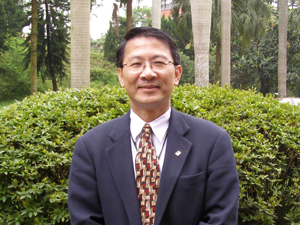
Welcome you all to the Institute of Information Science, Academia Sinica. As of July 1, 2006 it will mark the beginning of the ninth and final year of my last term as Director. The Institute has risen to its current state through considerable effort put forth by its faculty members and research engineers under the auspices of the distinguished members of its Advisory Committee and continuous support from the Academia Sinica. We conduct basic research in the core areas of information science as well as develop cutting-edge information technologies and advanced application-driven information systems. We adhere to quality, take great pride in our work and emphasize teamwork spirit in our working environment. I had the honor of getting elected Member of the Academia Sinica in 2004, joining this elite group of distinguished scholars in Taiwan and abroad. Our faculty members have won recognitions such as the Fellow of ACM, Fellow of IEEE, Academia Sinica Long-Term Researcher Award, Academia Sinica Outstanding Young Investigator Award, NSC Meritorious Research Fellow Award, NSC Outstanding Research Award, Ta-You Wu Memorial Award, ACM Taipei/Taiwan Chapter Kuo-Ting Li Young Researcher Award, Information Science Honorary Medal, Ten Most Outstanding Young Women Award, Outstanding Research Award of Pan Wen-Yuan Foundation, National Innovative Invention Award, etc. Let me give a brief account of what we have accomplished to date.
We have developed over the years an infrastructure for Chinese language processing which includes part-of-speech tagged corpora, tree-banks, Chinese lexical database, Chinese grammars, InfoMap, word identification systems, sentence parsers, etc. The infrastructure provides a suite of indispensable tools for automatic language understanding and knowledge extraction. These linguistic resources and processing technologies are open to the public and well known worldwide. For instance, the Academia Sinica Balanced Corpus containing five million words, which is the first balanced Chinese corpus with part-of-speech tagging, is available to the research community at http://www.sinica.edu.tw/SinicaCorpus/. The detailed descriptions for other resources can be found at http://rocling.iis.sinica.edu.tw/CKIP/ . We have also obtained new machine learning methods and applied them to improve various aspects of document analysis and recognition, including video caption recognition, handwritten character recognition, binarization of document images with non-uniform luminance, document layout analysis, etc. The machine learning methods can be used in other research areas and some of these techniques have been transferred to business sector. Our Chinese input system--GOING, which automatically translates a sequence of phonetic symbols into characters with a hit ratio close to 96%, is widely used in Taiwan. This system, which has basically solved the problem of typing Chinese on the computer, received the Distinguished Chinese Information Product Award in 1993. We have applied our natural language understanding model to Internet intelligent agents. With intelligent and friendly human-computer interfaces, these software agents can play the roles of spokesperson for companies on the Internet. These interface agents will become indispensable in the semantic search engine and the electronic commerce on the Internet. We have developed a screen recording and broadcasting system to record lectures held at IIS, which has evolved into a P2P version to facilitate group collaborations across Internet; a prototype of a digital library and a scalable full-text search engine and an Internet advertisement service system which delivers more than 10,000,000 banner advertisements per day ( http://www.yam.com/ ), and an automatic Internet document classification and management prototype. The application software has been in operation and some of them successfully transferred to industry. A web-based collaboratory ( http://webcollab.iis.sinica.edu.tw ) that supports different levels of collaboration is developed by incorporating the Zope/Plone shareware with clustering and mirroring features. The ShareTone Web Allies is used not only as an excellent knowledge management portal with the support of an ontology, but also as an online communication vehicle with a tele-conferencing system, and for synchronous collaboration with a suite of CSCW applications. To help protect intellectual property rights of digital media we have developed a digital watermarking technique and a digital rights management system. The watermarking technology, which won the 2004 National Innovative Invention Award, has been granted US, Canada and Taiwan patents. We have also developed an augmented panorama system that allows for integration of image-based objects into panoramas, and successfully transferred to the National Palace Museum and used for virtual exhibition of 3D artifacts.
We actively engage in cross-disciplinary research such as bioinformatics, and digital libraries, archives and museums, and in national-scale projects such as Open Source Software Foundry (OSSF), and Taiwan Information Security Center (TWISC). Through OSSF we hope to provide a common ground to foster development of free and open source software, promote interaction and collaboration between software development communities and private sector, create a free software sharing environment of benefit to all, and establish a solid foundation for free software development in Taiwan. TWISC on the other hand is an integrated effort, collaborating with research universities, to boost research and development activities in information security, to promote public awareness and foster partnership among government, academia and private sector in information security.
We envision ourselves to be in a forefront position in information science both in Taiwan and abroad, and we all share a common goal of making substantial impacts and contributions to the society and mankind for all. We would welcome your visit and appreciate your comments and suggestions.

June 2006
